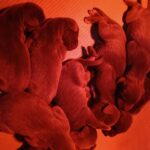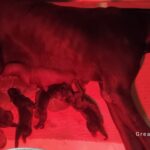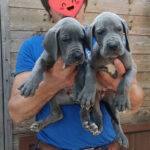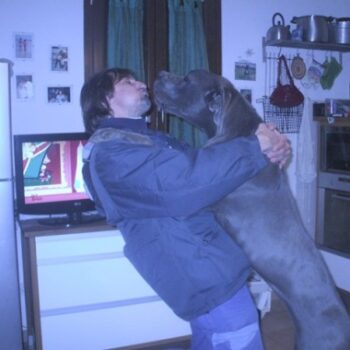
The Great Dane Illustrated Standard of Breed
- On 8 April 2011
- Great Dane, Standard
| 01 – Nose-truffle | 12 – Topline | 23 – Arm |
| 02 – Nose | 13 – Croup | 24 – Carpal joint |
| 03 – Lip | 14 – Anca | 25 – Pastern |
| 04 – Stop | 15 – Tail attack | 26 – Paw |
| 05 – Cheeks | 16 – Queue | 27 – Penis |
| 06 – Skull | 17 – Chest | 28 – Thigh |
| 07 – Throat | 18 – Rib cage | 29 – Knee |
| 08 – Ears | 19 – Chest bone | 30 – Leg |
| 09 – Neck | 20 – Shoulder | 31 – Tip of Hock |
| 10 – Attack of the neck | 21 – Forearm | 32 – Tarsus |
| 11 – Withers | 22 – Elbow | 33 – Metatarsus |

Origins: Germany
Date of publication the original Standard in force: 13 – 03 – 2001
Function: companion dog, Guard and protection.
Brief historical outline: The direct ancestors of the current German ’ great Dane are the ancient "Bullenbeiser" ’ and large males employed in hunting followed and in particular wild boar, structure and conformation dogs intermediate between a mighty hound English type (Mastiff) and a lightweight and agile Hound. Under the name Dogge was intended a great powerful dog that did not have to necessarily belong to a particular racial. Later designations Ulmer Dogge (Molossian of Ulm), Englische Dogge (English Bulldog), Danische Dogge (Molossus Danish), Hatzrude (Great hunting Male followed by), Saupacher (Acchiappascrofe or wild dog) and Grosse Dogge (Great molossus) have designated different types of dogs that were distinguished for the color of the coat and the mole. In 1878, in Berlin, a Committee composed of seven Judges, breeders and experts, under the chairmanship of Dr Bodinus, made the decision to group all these varieties under the name Deutsche Dogge (German Great Dane). In this way was laid the foundation stone for the ’ breeding of a breed of German origin. In 1880, on the occasion of an exhibition in Berlin ’, He was drafted the first Standard of the German Great Dane ’. Starting from 1888, the breed was entrusted to the "Deutscer Doggen Club 1888 e.V. ", over the years, the Standard has changed several times. Current form and content correspond to the model proposed by the F.C.I..
General appearance: In its general appearance the German Great Dane combines pride ’, strength and elegance in a set full of nobility. AND’ great, powerful and harmonious construction. The Great Dane, Thanks to the mole with distinction, all ’ harmony of ’ appearance, the proportion of forms, gives one who contemplates ’ the impression of being faced with a full statue of nobility. AND’ l ’ Apollo of breeds. Basic proportions: The trunk, especially that of males is part of the square. The length of the trunk (measured from the tip of the shoulder to the tip of the ’ pelvic) males should not exceed the 5% dell ’ height at the withers and females the 10%. Behavior and character: L ’ Alano has an instinctive goodness, affectionate and attacked his masters, especially to children, reserved with strangers. You must search for a suitable accompaniment to family life, without fears and confident, receptive to learning ’, lacking aggressiveness and equipped with high reaction threshold.

HEAD
Skull: Harmoniously proportioned in ’ together, long, close, with NET profiles, very expressive, finely chiselled (especially orbital region under ’); the arcades sopraciliari are well developed without, However, be salient. The distance from the ’ end of truffles at the Stop sign should correspond as closely as possible to the distance between the Stop and the occipital Crest, This last is not very pronounced ’. The upper lines of skull and muzzle should be parallele. In front of the head must appear close, the muzzle should be as wide as possible and cheek muscles (masseter) only slightly mentioned, never markedly in relief.
Stop: clearly pronounced
Truffle: Well developed, wider than rounded, with well opened nostrils. Must be black, with the exception of the Alans Harlequins ’, for whom the black truffle is wanted, but he admitted the truffle partially depigmentato (ladre) or color bumps.
Snout: Deep and more rectangular can. Labial commissures visible. Black pigmented lips. The Harlequins are the lips partially or completely depigmentate.
Jaws / teeth: Well-developed JAWS, wide. Robust dentition, sound and complete with scissor (42 teeth according to dental formula).
Eyes: Medium-sized with living expression, Smart and friendly, darker can, oval with eyelids fitting. In Blue great Danes are allowed a little eyes’ lighter. Harlequins are allowed in Alans eyes, gazzuoli or different color between their.
Ears: of course falling, attached high, medium-sized, with leading edge attached to the cheek.
Neck: Long, dry, brawny. Well developed at the base, tapers slightly towards the head, its profile is well arched neck region. Brought up, slightly inclined forward.
TRUNK
Withers: AND’ the highest point of the powerful trunk. AND’ the top edge of the shoulder blades that exceed the transverse spiny vertebrae.
Top line: Back short and well tended, almost straight, slightly inclined towards the rear.
Rene: Slightly rounded, wide and with strong musculature.
Croup: Large, ben muscolata, slightly inclined from the sacred to the root of the tail, merges seamlessly into the tail hanging ’.
Chest: descended to the level of the elbows. Well inclined to search coast towards the rear. Good width rib cage, with pronounced chest.
The bottom line: Belly ben retracted, to form a graceful curve that extends into the bottom line of the thorax.
Queue: Reaches the Hock. Attached high and wide, tapers progressively towards the ’ ends. In rest hangs in position naturally expanse, moving or when the dog is excited, SAG slightly Sabre, but without significantly surpass the line of the back. The tail with long hairs on the underside is not desired.
ARTS
Front
Shoulder: Equipped with powerful musculature. Long shoulder blade and oblique, to form with an arm angle between the 100 and the 110 degrees.
Arm: Robust and muscular, ben adhering to thoracic, must be a little’ the longer of the scapula.
Elbow: Should not be addressed or all ’ all ’ internal nor external. Forearm: Robust, brawny, perfectly composed both front profile.
The Carpus: Robust, solid, It continues with the forearm ’. Metacarpal: Robust, in perpendicularity seen from the front, only slightly inclined forward, seen in profile.
Front feet: Rotondi, with highly arched toes and well closed (Cat's foot). Nails strong Court, darker can.
Rear
L ’ l ’ skeleton of the whole rear is covered by powerful muscles that make the Croup, hips and thighs wide and rounded. Viewed from behind, the rear, robust and equipped with good angles, are parallel to the front. Thigh: Long, large, very muscular.
Stifle (knee): Solid, post all about vertical ’ on dell ’ anca. Leg: Long, more or less the same length of thigh, ben muscolata.
Hock: Solid, robust, neither external nor addressed all ’ all ’ inside. Metatarsus: Short, solid, almost perpendicular to the ground.
Hind Feet: Rotondo, with decidedly well arched toes closed (Cat's foot). Nails Court, resistant, darker can.
GAIT: Harmonious, soft, with good extension, slightly elastic; limbs as seen from the front or from behind, move parallel to the plane of the body.
SKIN: Ben adherent and bucklers. Well pigmented individuals unicolori; in people sharing Harlequins pigment corresponds essentially to the allocation of spots.

MANTLE:
Pelo: Short and thick, smooth, bright and well fitting to the body.
Color: L ’ great Dane is bred into three distinct color varieties: Fawn and Brindle, Harlequin and black, Blue.
Fawn : Mantle from yellow-light gold to deep golden yellow. AND’ the black mask. Small spots in the chest and feet are unwanted.
Brindle : Background color from yellow-light gold to deep golden yellow with black stripes and markedly more regular can draw, that follow the direction of the ribs; is the black mask. Small spots in the chest and feet are unwanted.
Harlequin black and white (said a time Tigerdoggen) : Pure white mantle Fund, as much as possible without moschettature, with black lacquer stains from various sized ripped edge and well distributed over the entire surface of the body. Grey or brown stains are partially unwanted.
Black : Black lacquer, white markings are allowed. Part of this variety the Alans Mantel Tiger, in which the black covers the torso like a mantle, While the muzzle, the neck, the chest, the belly and tail end ’ can be white, as well as the Alans Platten where the coat is white with large black spots.
Blue : Pure steel blue, white markings are allowed in the chest and feet.
MOLE: L ’ minimum height at the withers is 80 cm. for males and 72 cm. for females.
DEFECTS
Everything that deviates from what was previously said must be considered defect, that will be penalized according to the severity. In particular,:
General Appearance : Lack of sexual dimorphism. Lack of harmony of forms. Subject too light or too heavy.
Behavior and character : Lack of security. Nervousness. Low arousal threshold.
Head : Craniofacial axes not parallel. Convex skull (to Apple). Axio-facial lines converging. Stop little pronounced. Cheek muscles (masseter) too developed.
Snout : Pointed snout. Lips too underdeveloped, or too developed (floating lips).Concave nose, convex (montonina) or down to the next ’ (aquiline nose). Jaws / Teeth : Any diversity from a complete toothing (It admits only the ’ absence of P1, i.e. the first Premolar, in the lower jaw). The irregular position of incisors, Although it does not compromise the normal closure of the maxilla. Teeth too small.
Eyes : Eyelids not adhering to the eyeball. Conjunctiva flushed too. Clear eyes, Amber, washed-out blue eyes, eyes of different colour between their dogs monocolor. Eyes too far apart, too small, deep-set or protruding.
Ears : Attached too high or too low. Non-members or flattened against the cheeks.
Neck : Short, tozzo. Neck said of deer. The skin of the neck too loose, dewlap.
Topline : Sway back. Back of carp. Back too long. Withers higher than Croup.
Croup : Horizontal or inclined too.
Queue : Too coarse. Too short or too long. Attached flow too low or too high over the line of the back. Tail hook, rolled or diverted laterally. Scarred from head tail, enlarged to its end or amputated.
Chest : Flat or too search for coasts (barrel chest). Depth of chest width or insufficient. Sternum protruding too (chicken breast ).
The bottom line : Belly too little retracted. Breasts too obvious.
Forelimbs : Insufficient angles. Skeleton too light, undeveloped muscles. Perfect non-perpendicularity in station.
Shoulder : Sore shoulder inserted, too loaded. Scapula too straight.
Elbow : Low solidity of elbow. Diverted all ’ all internal or external ’.
Forearm : Non-perpendicularity. Increased volume at the Carpus.
The Carpus : Increased volume. Too tilted or too straight.
Metacarpal : Too bent or too vertical.
Hind Limbs : Angles too closed or too open. Hocks closed, vaccinismo or cagnolismo.
Hocks : increased volume. Little solids.
Feet : Dishes, dita open or too long. Speroni.
Gait : SWB. Stiff gait. Amble frequent or continued. Lack of coordination between front and rear.
Pelo : Pelo duro, dull hair.
Color :
FAWN : Greyish yellow mantle, bluish-yellow, isabella or dirty yellow
BRINDLE : The bottom of the mantle blue silver, isabella blue, stripes washed out.
HARLEQUIN : The bottom of the mantle blue grey dotted, stains largely yellowish or grey blue.
BLACK : Black with yellow reflexes, Brown or bluish.
BLUE : Coat with yellowish or blackish reflexes.
SERIOUS FAULTS
Behavior and character : Shyness.
Jaw / Teeth : Tenaglia closing.
Eyes : Ectropion, Entropion.
Queue : Broken tail.
FAULTS
Behavior and character : Aggressiveness, barbs for fear.
Truffle : Nose bumps, nostrils separated by a deep groove.
Jaw / Teeth : Prognathism, overshot, lateral deviation of mandible.
Hair colour : Dane Fawn and Brindle with white list, white collar, feet, balzane and white tail ends. Alans blue list, the collar, feet, balzane and white tail ends. Alans Harlequins : white subjects without any trace of black (Albini), deaf persons, Alani said Mantled porcelain, in which predominate the blue spots, Gray, Fawn or even tigrate; Alans Merle (bottom of the grey coat with black spots).
Mole : Below the minimum prescribed by the Standard.
Nota bene: Males have two testicles have descended into the scrotum look normal.







